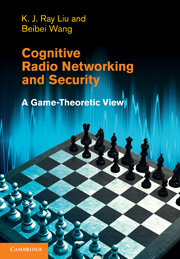Book contents
- Frontmatter
- Contents
- Preface
- Part I Cognitive radio communications and cooperation
- Part II Resource awareness and learning
- 10 Reinforcement learning for energy-aware communications
- 11 Repeated games and learning for packet forwarding
- 12 Dynamic pricing games for routing
- 13 Connectivity-aware network lifetime optimization
- 14 Connectivity-aware network maintenance and repair
- Part III Securing mechanism and strategies
- References
- Index
13 - Connectivity-aware network lifetime optimization
from Part II - Resource awareness and learning
Published online by Cambridge University Press: 06 December 2010
- Frontmatter
- Contents
- Preface
- Part I Cognitive radio communications and cooperation
- Part II Resource awareness and learning
- 10 Reinforcement learning for energy-aware communications
- 11 Repeated games and learning for packet forwarding
- 12 Dynamic pricing games for routing
- 13 Connectivity-aware network lifetime optimization
- 14 Connectivity-aware network maintenance and repair
- Part III Securing mechanism and strategies
- References
- Index
Summary
In this chapter, we consider a class of energy-aware routing algorithms that explicitly take into account the connectivity of the remaining sensor network for lifetime improvement. In typical sensor-network deployments, some nodes may be more important than other nodes because the failure of these nodes causes network disintegration, which results in early termination of information delivery. To mitigate this problem, we consider a class of routing algorithms called keep-connect algorithms, which use computable measures of network connectivity in determining how to route packets. Such algorithms embed the importance of the nodes in the routing cost/metric. The importance of a node is characterized by the algebraic connectivity of the remaining graph when that node fails. We prove several properties of the routing algorithm, including the energy-consumption upper bound. Using extensive simulations, we demonstrate that the algorithm achieves significant performance improvement compared with the existing routing algorithms. More importantly, we show that it is more robust in terms of algebraic network connectivity for lifetime improvement than the existing algorithms. Finally, we present a distributed implementation of the algorithm.
Introduction
Advances in low-power integrated-circuit devices and communications technologies have enabled the deployment of low-cost, low-power sensors that can be integrated to form a sensor network. This type of network has vastly important applications, i.e., from battlefield surveillance systems to modern highway and industry monitoring systems; from emergency rescue systems to early forest-fire detection and very sophisticated earthquake early-detection systems, etc. Having such a broad range of applications, the sensor network is becoming an integral part of human lives. Moreover, it has been identified as one of the most important technologies nowadays.
- Type
- Chapter
- Information
- Cognitive Radio Networking and SecurityA Game-Theoretic View, pp. 325 - 349Publisher: Cambridge University PressPrint publication year: 2010



